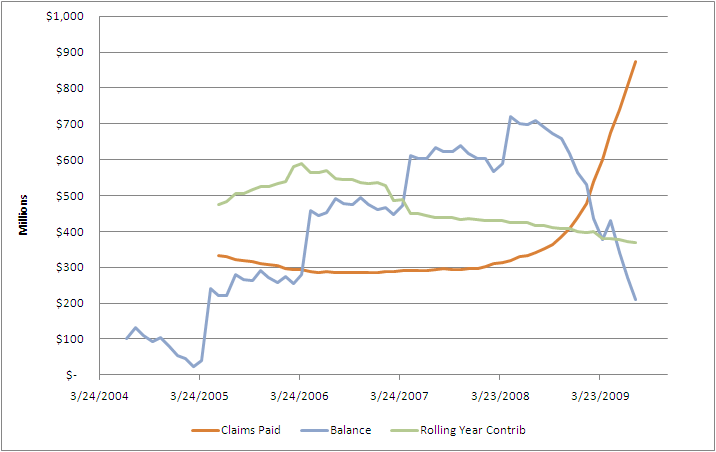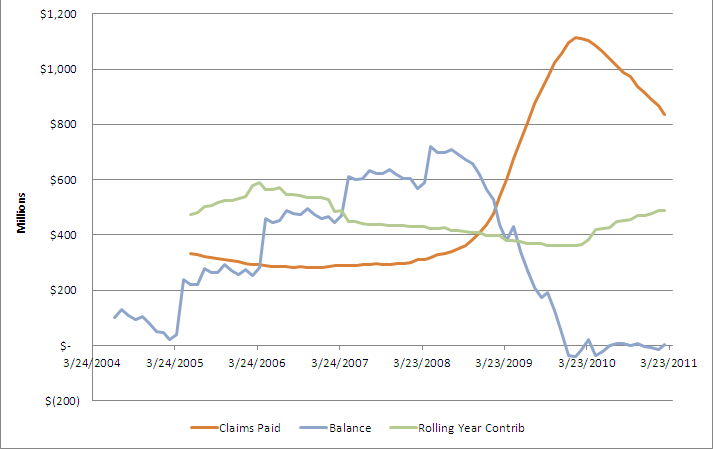Posts Tagged Unemployment
Infrastructure and Spending
Posted by Joshua Sharf in Business, Economics, PPC on September 6th, 2011
Word on the street is that President Obama will call for yet more “infrastructure” spending in his Wednesday Thursday night campaign speech address to Congress. Russ Roberts, of Econtalk, makes the effective rebuttal to this idea (as with most of the President’s ideas, it’s too amorphous to call it a “plan”) in two posts, “Crumbling“, and “Shovel Ready.” In Shovel Ready, he notes that Japan spent a decade spending money on “shovel ready” public works projects that provided little economic benefit above and beyond the circulation of currency for its own sake (or its own sake).
In Crumbling, he shows that we’ve been increasing the percentage of GDP spent on infrastructure for about three decades, and yet still hear complaints about “crumbling infrastructure.’ He then goes on to quote a New York Times column giving examples of waste here. One thing he doesn’t mention is that building pointless roads isn’t just a one-time expense – we’re stuck with the maintenance of those roads pretty much forever, lest they, too “crumble.”

Of course, this was before the most recent “stimulus,” and all those orange signs proclaiming spending throughout the land and to all the commutants thereof.
Taken as a whole, it’s a powerful argument against the sort of fire-hose spending “plan” that will likely be announced Thursday night.
I happen to believe that infrastructure is one of the proper areas for government spending, for a variety of reasons. How best to do that can be the subject of vigorous debate, but the story of the Kansas Turnpike shows the risks incurred when interstate projects aren’t attempted by an interstate authority. (For the moment, I’m happy to revisit the debates over political economy from the 1940s, but not the 1840s.)
All of this is what makes the first stimulus package such a shame. In the 1950s, we had the luxury of buying North Dakota’s support for I-95 with I-94. We could make a lot of mistakes, and still get the thing basically right. We don’t have that luxury now. Wasting almost $1,000,000,000,000 in “infrastructure” spending in 2009 doesn’t mean we get to go back and clean up the mess. It means we don’t have the money to do it right this time, so there is no this time.
A friend of mine likes to bemoan Americans who won’t spend on infrastructure, but it’s probably one of the few areas where the overwhelming majority of us actually do agree. And if the government weren’t so busy doing all the other things it shouldn’t be doing, it might actually have the attention and money to get this one right.
Bad News on the Colorado Jobs Front
Posted by Joshua Sharf in Business, Colorado Politics, Economics, PPC on August 19th, 2011
Colorado continues to shed workers and jobs, according to the latest release from the Bureau of Labor Statistics. On a seasonally-adjusted basis, Colorado’s unemployment rate held steady at 8.5%, but only because fewer people were looking for work.
| Labor Force | Employed | Unemployed | ||||||
|---|---|---|---|---|---|---|---|---|
| July 2010 | June 2011 | July 2011 | July 2010 | June 2011 | July 2011 | July 2010 | June 2011 | July 2011 |
| 2,682.8 | 2,682.0 | 2,674.4 | 2,446.2 | 2,453.2 | 2,447.9 | 236.6 | 228.8 | 226.5 |
| -8.4 | -7.6 | Change | 1.7 | -5.3 | Change | -10.1 | -2.3 | Change |
Since July of last year, we have 8400 fewer people in the labor force, and the number employed has barely budged. The number of unemployed has fallen roughly 10,000, but almost all of that is a result of people leaving the state or giving up. In the last month alone, the labor force shrank by 7600, and we lost 5300 jobs.
In the meantime, the average duration of unemployment has shot past 40 weeks:

This isn’t just lost income. It’s skills and connects that have gone stale, knowledge of their own market that has become outdated, and declining confidence that things will get better anytime soon.
The long-term unemployment is mostly among men, and mostly among less-educated, and those two classes increasingly overlap. Keep this sort of thing going long enough – and it doesn’t take too terribly long to become self-reinforcing – and we’re liable to have a lot of cities looking like last week’s London sometime before 2020.
GE, We Bring Bad Ideas To Light
Posted by Joshua Sharf in 2012 Presidential Race, Business, Economics, National Politics, PPC, Stimulus on June 15th, 2011
In a prior post, I mentioned that Obama’s favorite courtier CEO, Jeffrey Immelt, was part of a Jobs & Competitiveness Council, ostensibly tasked with finding ways to put Americans to work. It’s the kind of thing that government always says it’s doing, anyway. After all, we have a Commerce Department, a Labor Department, an Education Department, and dozens, if not hundreds, of bureaus, agencies, subalterns, and fiefdoms devoted exclusively to this problem.
From the bureaucracy’s point of view, they’ve spent decades of time, billions of taxpayer dollars, and millions in campaign contributions to get where they are, and they’re not going to let a hand-picked set of toadies show them up. The beauty of it is that either their success or their failure shows that our actual redundant population lives and works within 10 miles of the Capitol.
If by now anyone at all has any faith left in this kind of commission, it should be put to rest by its initial recommendations.
Not Keeping Pace
Posted by Joshua Sharf in Colorado Politics, PPC on June 3rd, 2011
Back in October 2009, I wrote a piece examining the state of Colorado’s Unemployment Insurance Fund, and concluded that making long-term changes in eligibility in return for some short-term federal crack cocaine cash was a terrible trade. There was a graph showing where our unemployment insurance fund was headed at the time, even before federal aid, and I use that term advisedly:

The “Claims Paid” is a rolling 12-month total, as are the contributions. Well, here’s that graph now:
Colorado Unemployment Insurance Fund

As you can see, the federal “aid” didn’t arrest the decline, it didn’t even hide the decline. At the beginning of 2010, Colorado’s bank balance hit $0.00, went past that, and had stayed there ever since. That $127 million that was so valuable and necessary funded the system for about 5 1/2 weeks at the peak of claims, about 8 weeks now.
These changes weren’t just an extension of benefits. Those extensions were supposed to be picked up by the feds. No, the $127 MM was in return for structural changes designed to permanently increase eligibility. Part of the justification for the increase was Mark Zandi’s claim that unemployment insurance payments had one of the highest multipliers of all forms of intervention. But it’s been pointed out that Zandi never explained how he got to that number, and the models used have never been subjected to outside scrutiny. Moody’s is no piker, but if policymakers are going to use their results, their models need to be subject to the same scrutiny that we give to global warming data. Cough.
The business contribution line, you’ll notice, has been rising. Well, that’s not because so many more people are employed now in Colorado than used to be. It’s because every May, CDLE is allowed to levy additional assessments on business when the fund falls below a certain level. Given that levels are those for a reservoir in Death Valley, the fund right now will meet any insolvency test you care to invent.
So now, when the federal government begins charging Colorado interest for the money loaned for the further benefits extensions, and when levels remain elevated at least in part because the terms for qualifying are more generous, Colorado is back asking (in the sense that the Stasi “asked” you not to make that joke, please) for even more money from businesses.
Ironically, the House sponsor of this financial wizardry was the man who now wants you to send him to Washington for more of the same – Rep. Sal Pace. Someone from our enterprising media, someone who does this sort of thing for a living, really ought to ask him about this, dontcha think?



